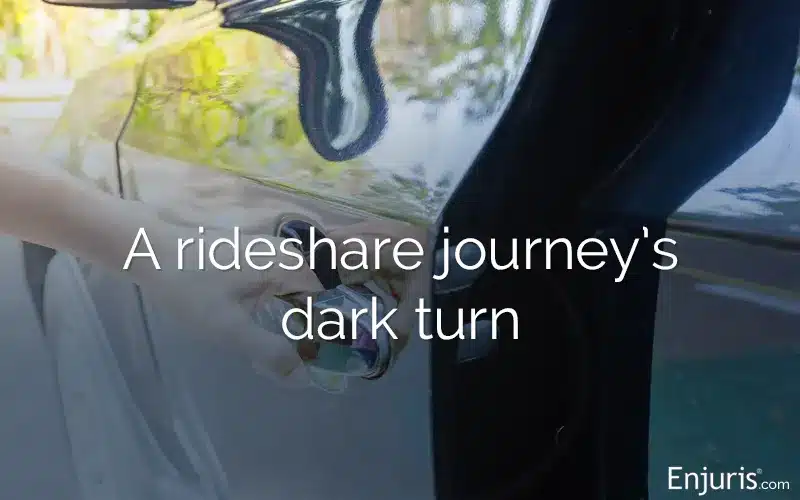
Who’s liable in a rideshare car accident?
Your days of hailing a yellow taxi by sticking your thumb up might be numbered. In the US, the use of rideshare services is growing daily.
Like any mode of transportation, rideshares aren’t perfect. But while rideshares have received plenty of negative publicity, there’s an issue that hasn’t gotten much media attention:
What happens when there’s a crash involving a rideshare vehicle?
The answer is more complicated than you might think. Let’s take a look.
What is a rideshare company?
Rideshare companies (sometimes called transportation network companies, peer-to-peer ridesharing, or ride-hailing companies) provide driver-for-hire services to consumers through the use of freelance drivers who use their personal vehicles to transport customers.
Rideshare services operate through a smartphone app. For example, if you want a ride from your apartment in Queens to the Brooklyn Museum, you only need to open up the app, request a ride, and wait for your driver to arrive. Once your driver drops you off at your destination, the credit card you stored on the app will automatically be charged.
Are rideshares dangerous?
Rideshare services offer convenience and often cost less than using a traditional taxi or driving your own vehicle. Still, there are concerns about how the services operate, including how well they screen their drivers.
What’s more, there have been a number of instances where passengers have been assaulted and even murdered after getting into a vehicle that they believed to be a rideshare vehicle, but that turned out to be a person posing as a rideshare driver.
There is also some evidence that rideshare services are making the roads even more dangerous.
In the years before Uber and Lyft were launched, fatal car accidents were at record lows. However, the arrival of ridesharing is associated with an increase of 2-3% in the number of fatal accidents, according to researchers John Barrios of the University of Chicago.
Who’s liable if you’re involved in a rideshare car accident?
Whether you’re a passenger in a rideshare vehicle or the driver of a vehicle that collides with a rideshare vehicle, liability will generally depend on who’s at fault for the accident.
To prove that someone was at fault (i.e. negligent) for a car accident, you must prove 3 elements:
- The person owed a duty of reasonable care (all drivers have a duty to drive carefully and obey all traffic laws)
- The person breached that duty (the other person didn’t drive carefully or didn’t obey a traffic law)
- You were injured and suffered damages as a result of the other person’s breach
Determining fault in a rideshare accident case is just like determining fault in a regular car crash. What makes rideshare accidents a little different is the role insurance plays when the injured party seeks reimbursement from the at-fault party.
Are Uber and Lyft drivers required to carry insurance?
Most drivers are covered by their personal auto insurance policy. This means that when you’re involved in a car accident, you can make a claim with the at-fault driver’s insurance policy and be reimbursed for your medical expenses and other damages.
However, personal auto insurance policies contain a business-use exclusion, which means that coverage doesn’t apply when the driver is using their vehicle for business purposes. This means that as soon as a rideshare driver picks up a customer, the rideshare driver has no liability insurance and also no collision insurance under their personal auto insurance policy.
So how do you get reimbursed if the rideshare driver is responsible for your injuries?
Both Uber and Lyft provide $1 million in liability coverage for their drivers. This sounds impressive, but the amount of coverage provided depends on which “period” the driver is in:
- Period 0: When the driver isn’t logged into the Uber/Lyft app, no coverage is provided (the driver’s personal auto insurance might apply).
- Period 1: When the driver is logged into the app but hasn’t accepted a ride request, Uber/Lyft provides liability coverage for any accident that’s the fault of the driver up to $50,000 per person and $100,000 total liability per accident.
- Period 2: When the driver has accepted a trip and is on the way to the pick-up location, liability coverage increases to $1 million.
- Period 3: When the customer is in the car, liability coverage of up to $1 million applies, plus limited coverage for damage to the driver’s car and uninsured motorist coverage.
Rideshare services — and the laws that govern them — are constantly evolving. For example, California recently implemented its own specific insurance requirements for rideshare drivers.
If you’re involved in a car accident with a rideshare driver, use our free online directory to connect with an attorney so that you can discuss your legal options.
New Details Emerge in Controversial Lyft Passenger Lawsuit
Explore the legal ramifications of a San Francisco Lyft driver's alleged misconduct. Stay informed about rideshare liability.
See our guide Choosing a personal injury attorney.

